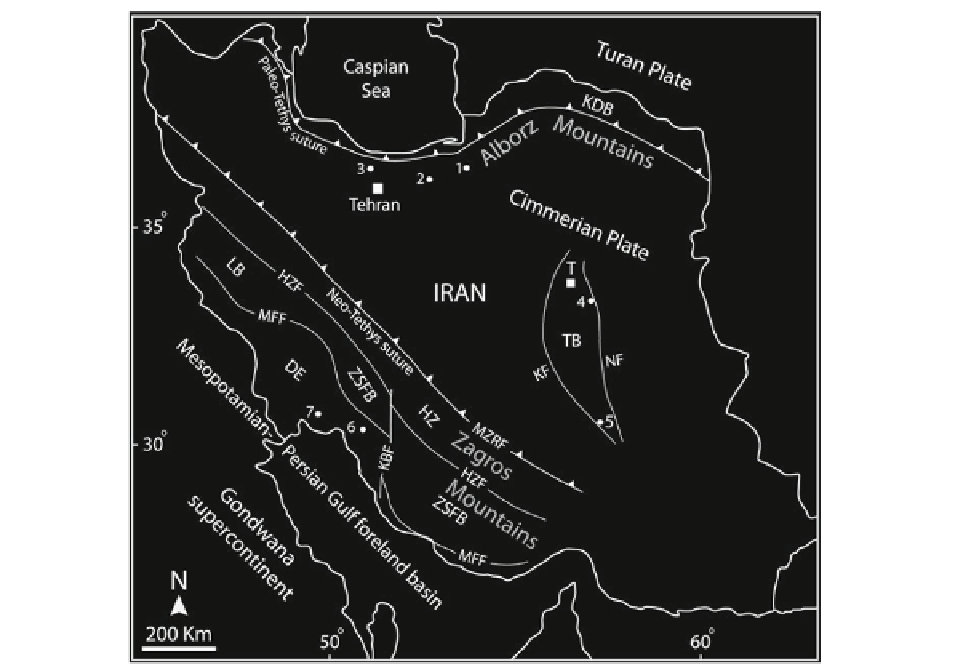Geology Reference
In-Depth Information
Fig. 21.25
Location map of Iran showing the structural fea-
tures, plate boundaries and the basins/sub-basins mentioned in
the text. The Cimmerian Plate between the Paleo-Tethys and
Neo-Tethys sutures includes central Iran and the Alborz
Mountains of northern Iran. The Zagros Mountains cover the
area between the Neo-Tethys suture and Mountain Front Fault
(
MFF
) in southwest Iran (fault traces are according to Berberian
1995
and Alavi et al.
1997
) . Numbered localities: (
1
) Tuyeh
section; (
2
) Veresk section; (
3
) Elika section (
4
) Godare Sorkh
section; (
5
) Eslamabad section; (
6
) Mish Mountain section;
(
7
) Agha-Jari section. Abbreviations:
DE
Dezful Embayment,
HZ
High Zagros,
HZF
High Zagros Fault,
KBF
Kazrun-Borazjan
Fault,
KDB
Kopet Dagh Basin,
KF
Kalmard/Kuhbanan Fault,
LB
Lurestan Sub-basin,
MZRF
Main Zagros Reverse Fault,
MFF
Mountain Front Fault,
NF
Nayband Fault,
T
Tabas (city),
TB
Tabas Basin,
ZSFB
Zagros Simply Folded Belt
with stromatolite reefs. Similar cycles are found in
many other Cambrian successions (e.g. Demicco
1985
;
Spencer and Demicco
1993
) .
The overlying sequence (Fig.
21.26
) includes trans-
gressive and highstand systems tracts built mainly by
small-scale shallowing-upward peritidal cycles con-
sisting of (1) bioturbated bioclast/peloid wacke-
stone-packstone (subtidal lagoon); (2) thin-bedded,
interlayered dolomudstone and peloid bioclast grain-
stone (Fig.
21.12b, c
) with ripple- wavy- lenticular
bedding and vertical burrows (lower intertidal); (3)
wavy to fl at laminated stromatolite (upper intertidal);
and (4) fenestral, mud-cracked dolomudstone with
common lamination (disrupted in places forming
collapse breccias) and calcite pseudomorphs after
gypsum/anhydrite crystals or nodules (supratidal).
Tidal deposits of the Middle Cambrian member 2 of
the Mila Formation were deposited in an arid homocli-
nal ramp, a vast epeiric sea that bordered the Proto-
Paleotethys Ocean. Peritidal facies (predominantly
tidal fl at) constitute the bulk of the transgressive and
highstand systems tracts and are arranged into high
frequency 4th to 5th-order shallowing-upward cycles
(Fig.
21.26b-f
). They are interlayered with erosive-
based fi ning-upward storm deposits consisting of
intraclasts, peloids, ooids and bioclasts of mixed fauna,
which suggest intermittent storm conditions during
deposition (Y. Lasemi and Amin-Rasouli
2002
) .

